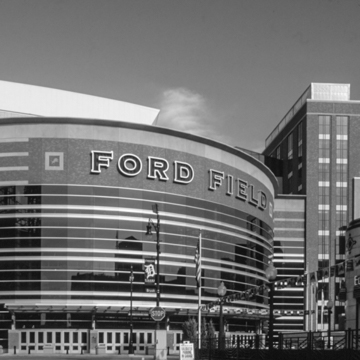The understated home of the Detroit Lions professional football team stands on a 25-acre site immediately northeast of the decorative Comerica Park (see WN31). Local boosters promoted the baseball and football stadia as economic development tools. In 1996, after the Detroit Lions announced plans to build a new domed stadium, voters of Wayne County overwhelmingly approved a referendum to allow the club to erect the facility next to a new baseball park. The cost of the athletic facility was met with public and private funding from the City of Detroit, Wayne County, the Downtown Development Authority, Detroit Lions, Inc., Ford Motor Company, Comerica Bank, and others.
The steel and concrete structure rests on a foundation of 380 concrete caissons. Horizontal bands of windows emulating Albert Kahn's factories evoke association with industrial Detroit. So does the incorporation of the old Hudson warehouse (1920s) into the design with a seven-story atrium and a huge glass wall through which the Detroit skyline is visible. Ford Field seats 65,000 spectators with four levels of suites and club seats and has concessions, restaurants, and retail space. Ford Field is also used for trade shows, conventions, and concerts.











